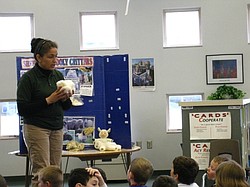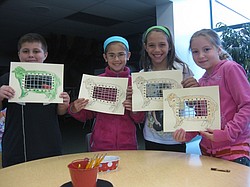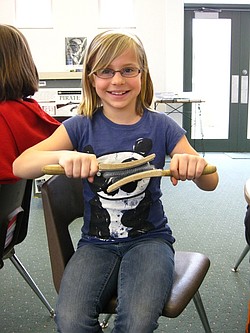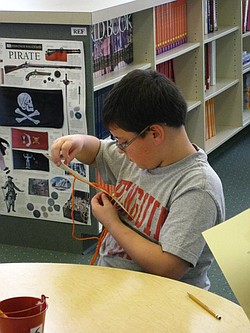Third-graders learn about wooly critters
Neighbors | Abby Slanker .Kim Moff, agricultural educator with Mill Creek MetroParks, visited C.H. Campbell Elementary School third-graders to teach them about wooly critters April 12.
Neighbors | Abby Slanker .Third-grade students at C.H. Campbell Elementary School had the opportunity to make an open weave loom using yarn and a piece of paper with a sheep on it during a visit from Kim Moff of Mill Creek MetroParks April 12.
Neighbors | Abby Slanker .A C.H. Campbell Elementary School third-grader tried her hand at carding wool during a visit from Kim Moff of Mill Creek MetroParks April 12.
Neighbors | Abby Slanker .A third-grade student at C.H. Campbell Elementary School concentrated on making his open weave loom during a visit from Kim Moff of Mill Creek MetroParks April 12.
By ABBY SLANKER
Third-grade students at C.H. Campbell Elementary School got a visit from Kim Moff, agricultural educator with Mill Creek MetroParks, to learn about wooly critters April 12.
As Moff explained, wooly critters are more than just sheep and include llamas, alpacas, angora rabbits and angora goats, but she would focus on sheep.
Moff proceeded to explain the process of how wool is taken from sheep and walked the children through the process of how the wool is used to make things.
“There are over 1,000 different kinds of sheep in the world. The sheep have different jobs on the farms and some sheep are raised just for their wool,” Moff said.
Moff explained to the students that both shears and clippers can be used to shave the fleece off a sheep.
“Farmers shear their sheep in the spring so the sheep have the whole winter to grow it back and it keeps them warm. It should come off in one piece and that is called fleece,” Moff said.
Moff told the children that the fleece, or raw wool, must be cleaned and the lanolin must be removed. The lanolin is then used to make soap, lotion, chap stick and lip gloss.
The wool is then brushed with cards, called carding and all the fibers must go one way, called roving. The wool can then be put on a spinning wheel and made into yarn. The yarn can then be used in knitting, crocheting and felting.
The students were then given an opportunity to make an open weave loom using yarn and a piece of paper with a sheep on it. Moff explained the process to the students and they completed the project as a souvenir of the program and what they had learned about wooly critters.
 43
43




